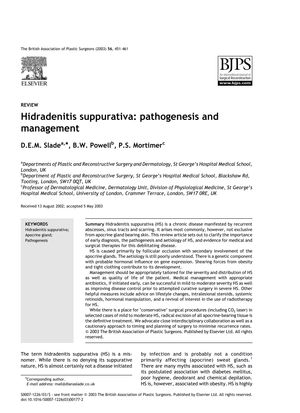Hidradenitis suppurativa: pathogenesis and management
July 2003
in “British Journal of Plastic Surgery”

TLDR Hidradenitis suppurativa, a chronic skin disease, can be managed with antibiotics, lifestyle changes, and in severe cases, surgery. Early diagnosis and careful planning are key, and laser treatment can be an efficient solution for mild to severe cases.
The 2003 review "Hidradenitis suppurativa: pathogenesis and management" discussed Hidradenitis suppurativa (HS), a chronic skin disease characterized by recurrent abscesses and scarring, primarily caused by follicular occlusion. The exact cause was unclear, but genetics, hormonal influences, obesity, and tight clothing were considered contributory factors. Management of HS was tailored to the severity of the disease and included antibiotics, lifestyle changes, hormonal manipulation, and radiotherapy. For severe cases, radical excision of all apocrine-bearing tissue was the definitive treatment. The authors advocated for interdisciplinary collaboration and a cautious approach to surgery to minimize recurrence rates. The study also found no significant differences in the size and density of the apocrine glands in HS compared to normal controls. Bacterial involvement in HS was controversial. Surgical management was considered the most effective treatment for severe HS, with complete excision of affected skin often needed to prevent recurrence. The study concluded that early diagnosis, control of the disease prior to surgery, and careful surgical planning were key for effective management. Laser treatment was found to be a rapid, efficient, and economical treatment for mild to moderate/severe HS, with complete healing time between 3 and 5 weeks.
View this study on jprasurg.com →
Cited in this study

research Finasteride as a therapy for hidradenitis suppurativa
Finasteride improves hidradenitis suppurativa but not for child-bearing women.